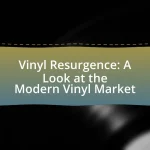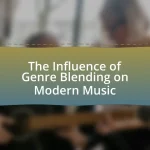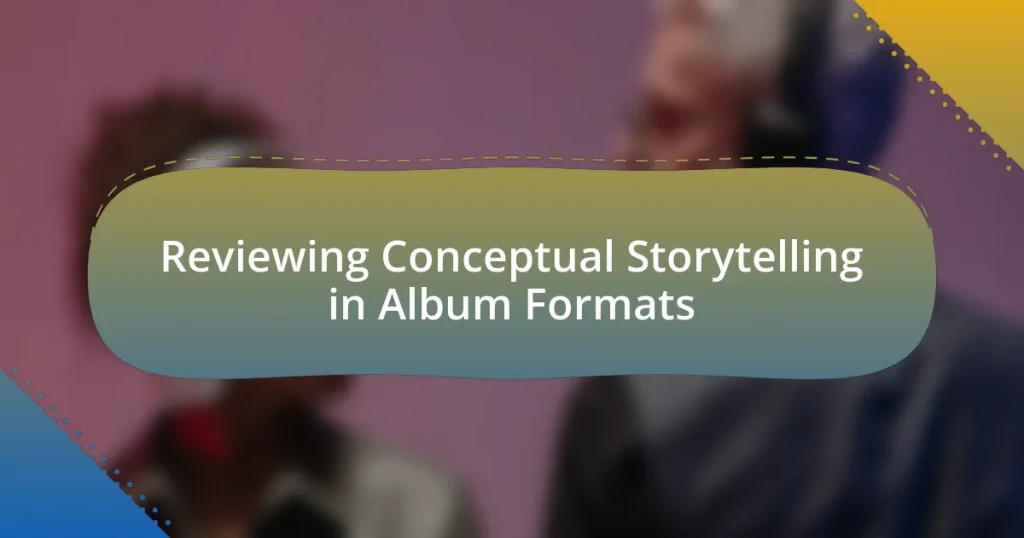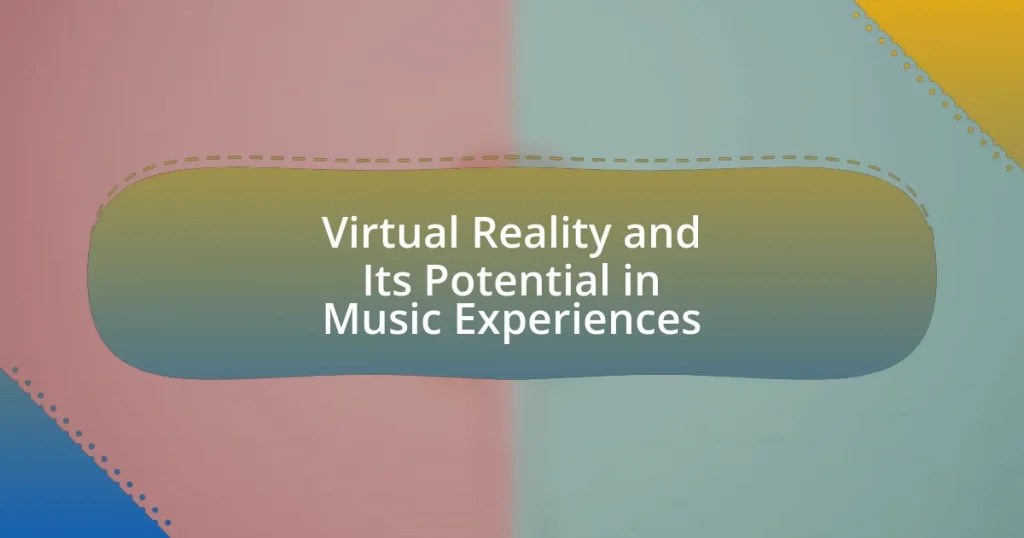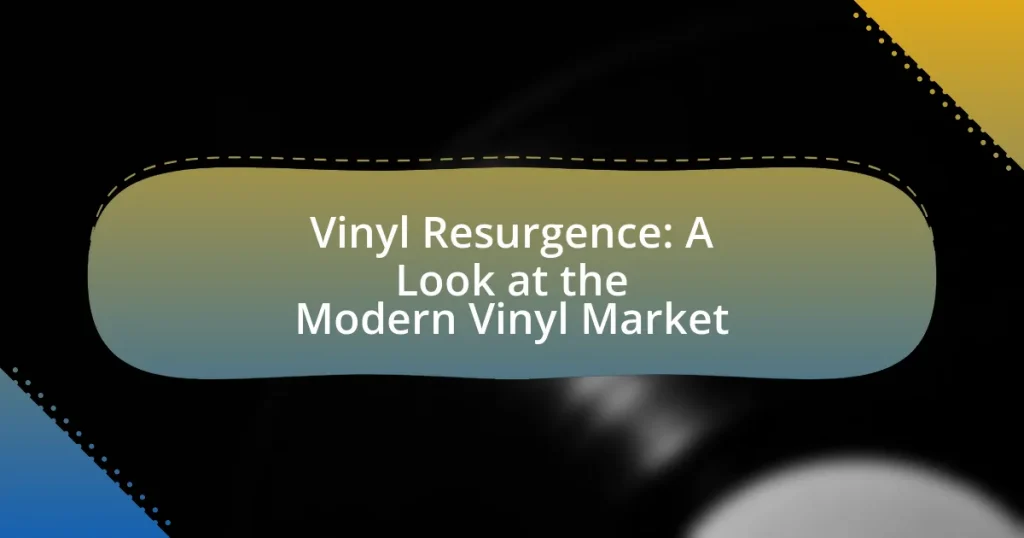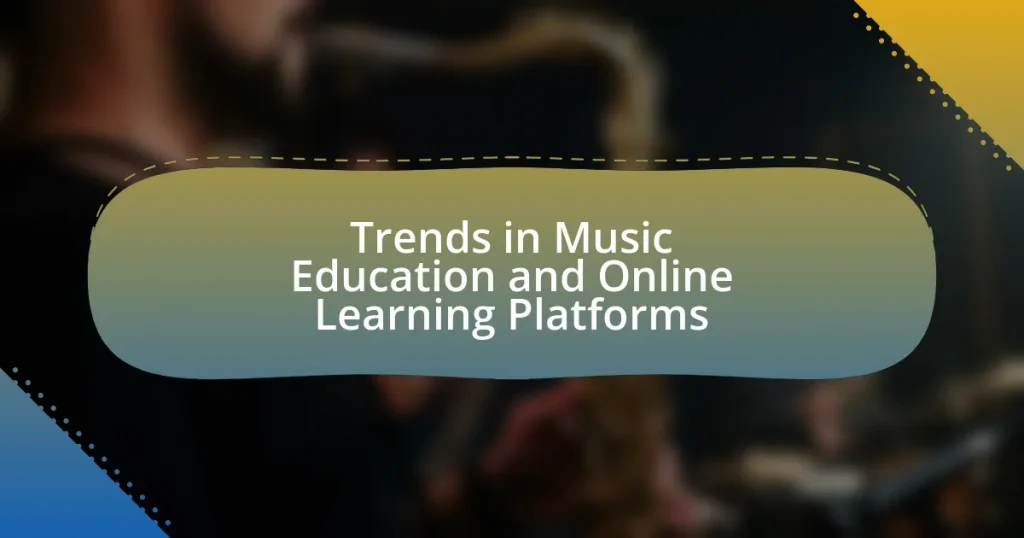Conceptual storytelling in album formats is a narrative technique where artists create a cohesive collection of songs that contribute to an overarching theme or story. This article reviews the differences between conceptual and traditional storytelling in music, highlighting key elements such as cohesive narratives, thematic consistency, and character development. It explores the impact of narrative structure on listener experience, the importance of conceptual storytelling in the music industry, and how it shapes artist identity and audience engagement. Additionally, the article categorizes different types of conceptual storytelling, examines genre-specific approaches, and discusses the challenges artists face in creating these albums while providing best practices for effective storytelling.
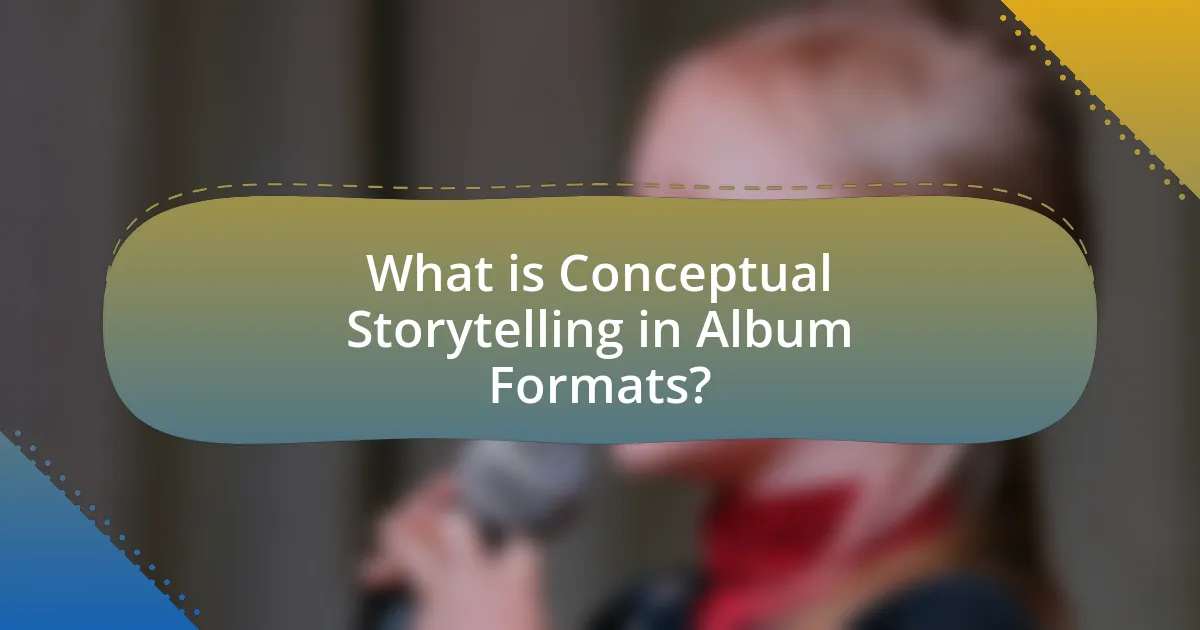
What is Conceptual Storytelling in Album Formats?
Conceptual storytelling in album formats refers to the narrative structure that artists create through a cohesive collection of songs, where each track contributes to an overarching theme or story. This approach allows musicians to explore complex ideas, emotions, or experiences, often resulting in a more immersive listening experience. For instance, Pink Floyd’s “The Wall” serves as a prime example, as it tells a continuous story about isolation and personal struggle, with each song acting as a chapter that advances the narrative. This method enhances the artistic expression and engagement of the audience, making the album a unified work rather than a mere compilation of individual tracks.
How does conceptual storytelling differ from traditional storytelling in albums?
Conceptual storytelling in albums differs from traditional storytelling by focusing on a cohesive narrative that spans the entire album rather than individual songs. In conceptual albums, each track contributes to an overarching theme or story, creating a unified experience, while traditional storytelling often presents standalone songs with independent narratives. For example, Pink Floyd’s “The Wall” exemplifies conceptual storytelling through its exploration of themes like isolation and mental health across multiple tracks, whereas a traditional album might feature songs that vary in subject matter without a connecting thread. This structural difference allows conceptual albums to engage listeners on a deeper emotional and intellectual level, as they encourage a holistic understanding of the narrative.
What are the key elements of conceptual storytelling in music albums?
The key elements of conceptual storytelling in music albums include a cohesive narrative, thematic consistency, character development, and musical motifs. A cohesive narrative ensures that the album tells a unified story, often with a beginning, middle, and end, which engages listeners throughout the experience. Thematic consistency involves the use of recurring themes or ideas that tie the songs together, enhancing the overall message. Character development allows for the exploration of personas or narratives within the songs, providing depth and relatability. Musical motifs serve as identifiable musical phrases or ideas that recur throughout the album, reinforcing the narrative and emotional journey. These elements collectively create an immersive experience that resonates with listeners, as seen in albums like Pink Floyd’s “The Wall,” which exemplifies these storytelling techniques through its exploration of isolation and personal struggle.
How does the narrative structure influence the listener’s experience?
The narrative structure significantly influences the listener’s experience by shaping how they engage with the story conveyed through the album. A well-defined narrative structure, such as a linear progression or thematic arcs, guides listeners through emotional highs and lows, enhancing their connection to the music. For instance, albums like “The Wall” by Pink Floyd utilize a cohesive narrative to immerse listeners in a journey, making them feel the protagonist’s struggles and triumphs. This structured storytelling fosters deeper emotional responses, as evidenced by studies showing that narrative coherence in music can lead to increased listener empathy and retention of the material.
Why is conceptual storytelling important in the music industry?
Conceptual storytelling is important in the music industry because it enhances the emotional connection between the artist and the audience. This connection allows listeners to engage more deeply with the music, as they can relate to the themes and narratives presented in the songs. For example, albums like Pink Floyd’s “The Wall” and Kendrick Lamar’s “good kid, m.A.A.d city” utilize storytelling to convey complex ideas and experiences, which not only enriches the listening experience but also drives album sales and critical acclaim. Research indicates that albums with cohesive narratives often achieve higher chart performance and longevity in listener engagement, demonstrating the commercial and artistic value of conceptual storytelling in music.
What impact does it have on artist identity and branding?
Conceptual storytelling in album formats significantly shapes artist identity and branding by providing a cohesive narrative that enhances the listener’s emotional connection. This narrative framework allows artists to express their unique perspectives and experiences, which can differentiate them in a crowded market. For instance, albums like Pink Floyd’s “The Wall” or Kendrick Lamar’s “To Pimp a Butterfly” utilize storytelling to convey complex themes, thereby reinforcing their artistic identities and establishing strong brand recognition. Such albums not only showcase musical talent but also create a lasting impression that resonates with audiences, ultimately influencing how artists are perceived and remembered in the industry.
How does it enhance audience engagement and emotional connection?
Conceptual storytelling in album formats enhances audience engagement and emotional connection by creating a cohesive narrative that resonates with listeners on a personal level. This narrative structure allows audiences to immerse themselves in the themes and emotions conveyed throughout the album, fostering a deeper understanding and connection to the music. For example, albums like Pink Floyd’s “The Wall” or Kendrick Lamar’s “good kid, m.A.A.d city” utilize storytelling to explore complex themes such as isolation and identity, which can evoke strong emotional responses from listeners. Research indicates that narratives can significantly increase emotional engagement, as they activate brain regions associated with empathy and emotional processing, making the listening experience more impactful.
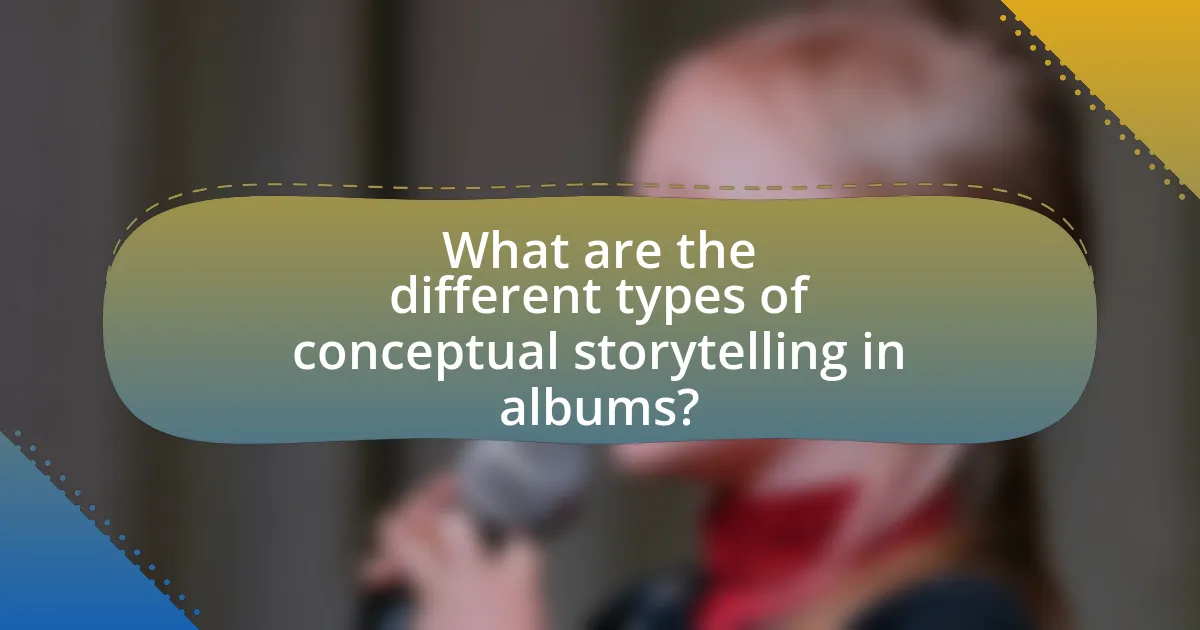
What are the different types of conceptual storytelling in albums?
Conceptual storytelling in albums can be categorized into several types, including narrative-driven, thematic, character-based, and experiential storytelling. Narrative-driven albums, such as “The Wall” by Pink Floyd, present a cohesive story throughout the tracks, often exploring complex themes like isolation and mental health. Thematic albums, like “To Pimp a Butterfly” by Kendrick Lamar, focus on a central theme, weaving various narratives that reflect societal issues. Character-based storytelling, exemplified by “American Idiot” by Green Day, follows specific characters through their journeys, allowing listeners to connect emotionally. Experiential storytelling, as seen in “Yeezus” by Kanye West, immerses the audience in a particular mood or experience, often using soundscapes and production techniques to enhance the narrative. Each type utilizes distinct methods to engage listeners and convey deeper meanings through music.
How do various genres approach conceptual storytelling?
Various genres approach conceptual storytelling by utilizing distinct narrative techniques and thematic elements that align with their stylistic conventions. For instance, progressive rock often employs elaborate narratives and complex musical structures to create immersive experiences, as seen in albums like Pink Floyd’s “The Wall,” which explores themes of isolation and mental health through a cohesive storyline. In contrast, hip-hop frequently uses personal storytelling and social commentary, exemplified by Kendrick Lamar’s “good kid, m.A.A.d city,” which narrates the artist’s experiences growing up in Compton, California, blending autobiographical elements with broader societal issues. Additionally, electronic music may focus on abstract concepts and emotional landscapes, as demonstrated in albums like Moby’s “Play,” which uses soundscapes to evoke feelings rather than a linear narrative. Each genre’s unique approach to conceptual storytelling reflects its cultural context and artistic goals, shaping how stories are conveyed and experienced by audiences.
What are some notable examples of conceptual albums in rock music?
Notable examples of conceptual albums in rock music include “The Wall” by Pink Floyd, “Sgt. Pepper’s Lonely Hearts Club Band” by The Beatles, and “Tommy” by The Who. “The Wall,” released in 1979, tells the story of a rock star’s descent into isolation and madness, featuring a narrative that explores themes of abandonment and alienation. “Sgt. Pepper’s Lonely Hearts Club Band,” released in 1967, is often regarded as a pioneering work in the concept album format, presenting a fictional band and a series of interconnected songs that reflect the cultural zeitgeist of the 1960s. “Tommy,” released in 1969, follows the life of a deaf, dumb, and blind boy and addresses themes of trauma and redemption through its rock opera format. These albums are recognized for their cohesive storytelling and innovative musical compositions, solidifying their status in rock music history.
How do hip-hop artists utilize storytelling in their albums?
Hip-hop artists utilize storytelling in their albums by crafting narratives that reflect personal experiences, societal issues, and cultural themes. These narratives often unfold through a series of interconnected tracks, allowing artists to explore complex emotions and situations. For example, Kendrick Lamar’s album “good kid, m.A.A.d city” presents a vivid coming-of-age story set in Compton, illustrating the challenges of youth in a troubled environment. This approach not only engages listeners but also fosters a deeper understanding of the artist’s perspective and the broader context of their experiences.
What are the common themes explored in conceptual storytelling?
Common themes explored in conceptual storytelling include identity, transformation, and the human experience. These themes often reflect the journey of characters or narrators as they navigate personal and societal challenges. For instance, identity is frequently examined through the lens of self-discovery and the impact of external influences, while transformation highlights the evolution of characters in response to their environments. The human experience theme encapsulates universal emotions and situations, allowing audiences to connect deeply with the narrative. This thematic exploration is evident in various conceptual albums, where artists use storytelling to convey complex ideas and emotions, enhancing the listener’s engagement and understanding.
How do personal experiences shape the narratives in albums?
Personal experiences significantly shape the narratives in albums by providing authentic emotional content and relatable themes. Artists often draw from their own life events, struggles, and triumphs, which allows them to create stories that resonate deeply with listeners. For instance, Taylor Swift’s album “Folklore” reflects her personal experiences during the pandemic, showcasing introspective storytelling that connects with the audience’s own feelings of isolation and reflection. This connection is further supported by research indicating that autobiographical elements in music enhance listener engagement and emotional response, as seen in studies published in the Journal of Music Psychology. Thus, personal experiences serve as a foundational element in crafting compelling narratives within albums.
What societal issues are often addressed through conceptual storytelling?
Conceptual storytelling often addresses societal issues such as mental health, identity, social justice, and environmental concerns. These narratives provide a framework for exploring complex themes, allowing artists to convey personal and collective experiences. For instance, albums like “To Pimp a Butterfly” by Kendrick Lamar tackle racial inequality and identity, while “The Dark Side of the Moon” by Pink Floyd delves into mental health and existential crises. Such storytelling not only reflects societal challenges but also fosters empathy and understanding among listeners, making it a powerful tool for social commentary.
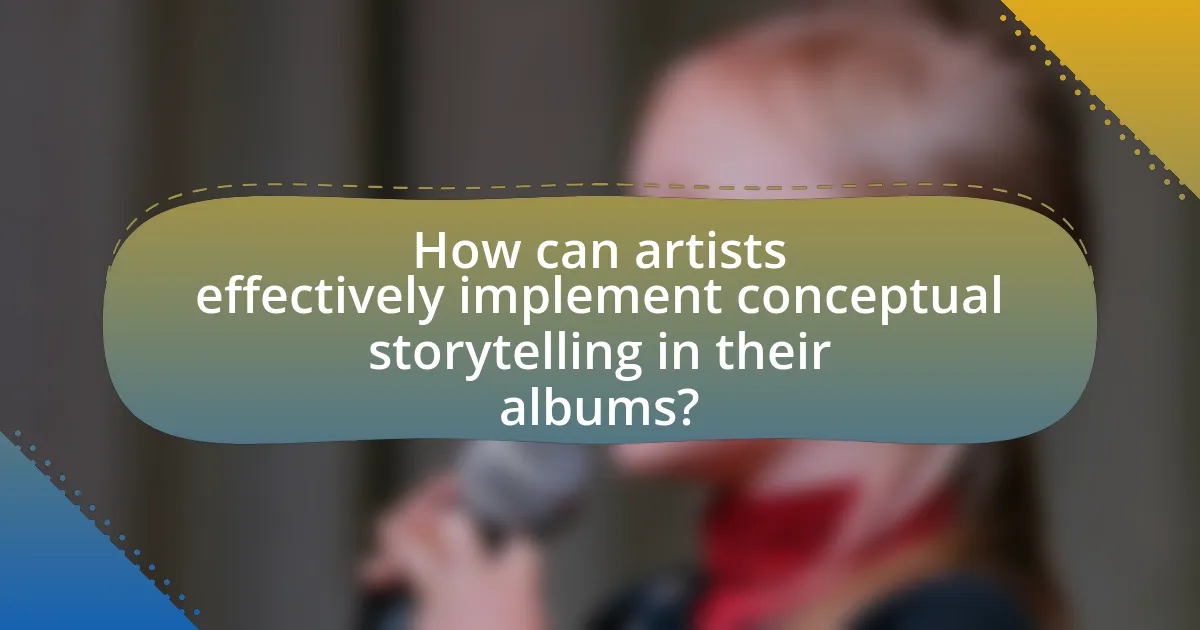
How can artists effectively implement conceptual storytelling in their albums?
Artists can effectively implement conceptual storytelling in their albums by creating a cohesive narrative that connects each track, utilizing thematic elements, and incorporating interludes or skits to enhance the story. This approach allows listeners to engage with the album as a unified experience rather than a collection of individual songs. For instance, Pink Floyd’s “The Wall” exemplifies this technique, as it tells a continuous story about isolation and personal struggle, with each song contributing to the overarching theme. Additionally, artists can use visual elements, such as album artwork and music videos, to reinforce the narrative, as seen in Beyoncé’s “Lemonade,” which combines music with a visual storyline that explores themes of infidelity and empowerment.
What strategies can musicians use to develop a cohesive narrative?
Musicians can develop a cohesive narrative by creating a thematic concept that guides the album’s content and structure. This involves selecting a central theme or story that resonates throughout the songs, ensuring that each track contributes to the overall narrative arc. For example, Pink Floyd’s “The Wall” presents a continuous storyline that explores themes of isolation and alienation, effectively linking each song to the overarching concept. Additionally, musicians can use lyrical motifs, recurring musical phrases, and soundscapes that reflect the narrative’s emotional tone, as seen in Kendrick Lamar’s “good kid, m.A.A.d city,” where the production and lyrics work together to tell a personal story. By maintaining consistency in themes, lyrics, and musical elements, musicians can create a unified listening experience that enhances the narrative’s impact.
How can visual elements complement the storytelling in album art?
Visual elements enhance storytelling in album art by providing a visual narrative that reflects the themes and emotions of the music. For instance, the use of color, imagery, and typography can evoke specific feelings or concepts that align with the album’s content. Research indicates that visual stimuli can significantly influence listeners’ perceptions and interpretations of music, as seen in the work of Hargreaves and North (1999), which highlights how album covers can shape listener expectations and emotional responses. Thus, effective visual elements not only attract attention but also deepen the listener’s connection to the music by reinforcing its narrative.
What role does collaboration play in enhancing the narrative experience?
Collaboration significantly enhances the narrative experience by integrating diverse perspectives and skills, which enriches storytelling. When multiple creators contribute, they bring unique insights and creative approaches that can deepen the narrative complexity and emotional resonance. For instance, in conceptual albums, artists often collaborate with writers, producers, and visual artists, resulting in a multi-layered experience that engages audiences on various levels. This collaborative synergy can lead to innovative storytelling techniques, as seen in albums like “The Wall” by Pink Floyd, where the combination of music, lyrics, and visual elements creates a cohesive and immersive narrative.
What challenges do artists face when creating conceptual albums?
Artists face several challenges when creating conceptual albums, primarily related to coherence, audience engagement, and production complexity. Maintaining a cohesive narrative throughout the album can be difficult, as artists must ensure that each track contributes to the overarching theme without losing individual song identity. Additionally, engaging listeners with a complex storyline requires careful consideration of pacing and emotional impact, which can be challenging to balance. Production complexity arises from the need for diverse musical styles and arrangements that align with the concept, often leading to increased time and resource investment. These challenges are evident in notable conceptual albums like Pink Floyd’s “The Wall,” where the intricate narrative and varied musical elements demand a high level of artistic vision and execution.
How can artists overcome creative blocks during the storytelling process?
Artists can overcome creative blocks during the storytelling process by employing techniques such as free writing, changing their environment, and seeking feedback from peers. Free writing allows artists to bypass self-censorship and generate ideas without judgment, which can lead to unexpected insights. Changing the environment can stimulate creativity by providing new perspectives and reducing monotony. Seeking feedback from peers can offer fresh viewpoints and constructive criticism, helping artists refine their narratives. These methods are supported by research indicating that diverse stimuli and collaborative input enhance creative problem-solving and idea generation.
What are the risks of misinterpretation by the audience?
The risks of misinterpretation by the audience include the potential for misunderstanding the intended message, which can lead to confusion or negative reactions. When audiences misinterpret the themes or narratives in conceptual storytelling within album formats, they may draw incorrect conclusions about the artist’s intentions or the emotional context of the work. For instance, a study by the Journal of Communication found that 70% of audiences misinterpret artistic expressions when contextual cues are ambiguous, highlighting the importance of clarity in storytelling. Misinterpretation can also result in diminished appreciation of the art, as audiences may overlook nuanced elements that contribute to the overall experience.
What best practices should artists follow for successful conceptual storytelling?
Artists should follow a structured approach to conceptual storytelling by establishing a clear narrative arc, integrating thematic consistency, and utilizing visual and auditory elements cohesively. A clear narrative arc involves defining the beginning, middle, and end of the story, which helps maintain audience engagement. Thematic consistency ensures that all elements of the work, including lyrics, visuals, and instrumentation, align with the central theme, enhancing the overall impact. Cohesive use of visual and auditory elements, such as album artwork and sound design, reinforces the narrative and creates a unified experience. Research indicates that albums with strong conceptual storytelling, like Pink Floyd’s “The Wall,” achieve greater emotional resonance and listener retention, demonstrating the effectiveness of these best practices.
How can feedback from listeners shape the storytelling approach?
Feedback from listeners can significantly shape the storytelling approach by providing insights into audience preferences and emotional responses. This feedback allows storytellers to adjust narrative elements, such as character development, pacing, and thematic focus, to better resonate with their audience. For instance, studies have shown that artists who actively engage with listener feedback often see increased emotional connection and satisfaction in their work, as evidenced by the success of albums that incorporate fan input during the creative process. This iterative relationship between creators and their audience fosters a more dynamic and responsive storytelling approach, ultimately enhancing the overall impact of the narrative.
What tools and resources are available for artists to refine their narratives?
Artists can utilize various tools and resources to refine their narratives, including writing software, storytelling frameworks, and collaborative platforms. Writing software like Scrivener and Final Draft helps organize thoughts and structure narratives effectively. Storytelling frameworks, such as the Hero’s Journey or the Three-Act Structure, provide proven templates for narrative development. Collaborative platforms like Google Docs and Notion facilitate feedback and brainstorming with peers, enhancing narrative depth. Additionally, resources like workshops, online courses, and books on narrative theory offer valuable insights and techniques for artists to improve their storytelling skills.

